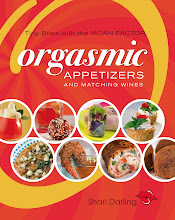 I even like the name Bacon. You can’t tell me the success of Kevin Bacon isn’t somehow tied to his name. You’re not going out to see a Kevin Hot Dog movie. “Who’s in this movie?” “Kevin Bacon.” “Sounds good.” -- Anonymous
I even like the name Bacon. You can’t tell me the success of Kevin Bacon isn’t somehow tied to his name. You’re not going out to see a Kevin Hot Dog movie. “Who’s in this movie?” “Kevin Bacon.” “Sounds good.” -- AnonymousCertain ingredients act as a bridge, bringing a dish into harmony with a particular wine. Bacon is one of them. Bacon is an excellent bridging ingredient to match to austere red wines. Austere reds include South African Pinotage, Italian Barolo or Barbaresco, Californian Cabernet Sauvignon, French Margaux and some Ontario Baco Noir. Bacon’s three wine friendly qualities are fattiness, smokiness and saltiness.
In hot climatic regions grapes attain high sugar levels. The higher the sugar level, the greater the alcohol content in the wine because sugar converts to alcohol and carbon dioxide during fermentation. The carbon dioxide dissipates, leaving the alcohol in the wine. The level of alcohol in a wine contributes to its viscosity (thickness). The more thickness, the greater the oily mouth feel to the wine. High alcohol gives red wine an oily mouth feel or fatty character.
Add to this that most austere reds undergo barrel fermentation and/or aging. The barrels are handcrafted from different species of oak, grown in forests in France, the US or Hungary. Each forest produces wood with distinctive characteristics involving tightness of the wood grain, ultimately affecting the amount of colour, flavour, taste and tannin (bitterness) imparted to the wine. New barrels also add more flavor and tannin. During barrel making, the partially assembled barrel is placed over a small wood fire and the inside is toasted. Barrels are generally light, medium or heavily toasted. The depth of toasting depends on the grape variety used and the style of wine to be made. The level of toasting affects the type and depth of flavor in the wine.
Red wines fermented and/or aged in heavily toasted oak barrels often possess a smoky, burned caramel flavour and some bitterness. These characteristics are a natural complement to the hickory or apple-wood smoked flavours of some bacon varieties.
Curing also makes bacon salty. The saltiness of bacon softens the bitterness in an austere red, leaving a creamy texture that blends with the fatty mouth feel. So, austere reds – ones barrel fermented and/or aged and high in alcohol -- possess fattiness, smokiness and bitterness that complement dishes containing bacon. Bacon is the bridge.
You can virtually add bacon to a variety of dishes, making them compatible for an austere red wine. Bacon wrapped beef or lamb tenderloin and austere red wine is a marriage made in heaven.
When bacon is teamed up with other red wine friendly ingredients, you can create classic combinations that harmonize with austere red wines. Bacon and roquefort, bacon with spinach, bacon with roasted onions or bacon and wild mushrooms are examples. Any one of these ingredient combinations can be added to a dish of pasta, risotto or polenta and be matched to an austere red.
Certain herbs harmonize with bacon, as well, ultimately complementing this same wine style. Thyme is an example. Nothing could be more enjoyable along side a class of South African Pinotage than a rack of lamb with sausage, bacon and thyme or pan-fried chicken with bacon and thyme gravy. Or better still, how about bacon wrapped quail with curly endive, toasted walnuts and balsamic thyme vinaigrette?
So, the next time you think austere red, consider adding bacon to bridge the relationship.
In hot climatic regions grapes attain high sugar levels. The higher the sugar level, the greater the alcohol content in the wine because sugar converts to alcohol and carbon dioxide during fermentation. The carbon dioxide dissipates, leaving the alcohol in the wine. The level of alcohol in a wine contributes to its viscosity (thickness). The more thickness, the greater the oily mouth feel to the wine. High alcohol gives red wine an oily mouth feel or fatty character.
Add to this that most austere reds undergo barrel fermentation and/or aging. The barrels are handcrafted from different species of oak, grown in forests in France, the US or Hungary. Each forest produces wood with distinctive characteristics involving tightness of the wood grain, ultimately affecting the amount of colour, flavour, taste and tannin (bitterness) imparted to the wine. New barrels also add more flavor and tannin. During barrel making, the partially assembled barrel is placed over a small wood fire and the inside is toasted. Barrels are generally light, medium or heavily toasted. The depth of toasting depends on the grape variety used and the style of wine to be made. The level of toasting affects the type and depth of flavor in the wine.
Red wines fermented and/or aged in heavily toasted oak barrels often possess a smoky, burned caramel flavour and some bitterness. These characteristics are a natural complement to the hickory or apple-wood smoked flavours of some bacon varieties.
Curing also makes bacon salty. The saltiness of bacon softens the bitterness in an austere red, leaving a creamy texture that blends with the fatty mouth feel. So, austere reds – ones barrel fermented and/or aged and high in alcohol -- possess fattiness, smokiness and bitterness that complement dishes containing bacon. Bacon is the bridge.
You can virtually add bacon to a variety of dishes, making them compatible for an austere red wine. Bacon wrapped beef or lamb tenderloin and austere red wine is a marriage made in heaven.
When bacon is teamed up with other red wine friendly ingredients, you can create classic combinations that harmonize with austere red wines. Bacon and roquefort, bacon with spinach, bacon with roasted onions or bacon and wild mushrooms are examples. Any one of these ingredient combinations can be added to a dish of pasta, risotto or polenta and be matched to an austere red.
Certain herbs harmonize with bacon, as well, ultimately complementing this same wine style. Thyme is an example. Nothing could be more enjoyable along side a class of South African Pinotage than a rack of lamb with sausage, bacon and thyme or pan-fried chicken with bacon and thyme gravy. Or better still, how about bacon wrapped quail with curly endive, toasted walnuts and balsamic thyme vinaigrette?
So, the next time you think austere red, consider adding bacon to bridge the relationship.






